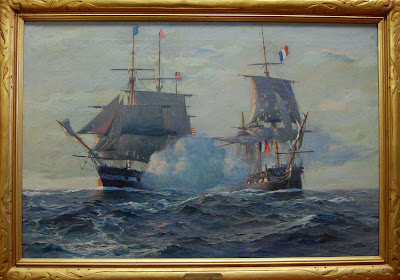Live War Game Demonstration: Pre-Game Briefing Part 1
We hope you will join us on Friday, April 10 at 7:00PM EST for our live war game demonstration on the museum’s Facebook page. We invite everyone to watch, comment, and ask questions as we play through a scenario from the Battle of Okinawa. Knowledge of the history behind the battle is not necessary to enjoy the game, but those who are interested in the events leading up to the invasion may wish to read on about planning for Operation ICEBERG.
On April 1, 1945, more than 1,300 ships of the U.S. Navy’s Fifth Fleet assembled off Okinawa to begin landing operations. The troops they carried into battle belonged to Tenth Army, a unique command consisting of four Army divisions and three Marine divisions. Nearly 183,000 soldiers belonged to Tenth Army on the day the battle began. They could count on naval and air support from 19 fast carriers of Task Force 58 and the British Pacific Fleet, 10 battleships, 17 cruisers, and 60 destroyers. Still more firepower was available in the form of escort carriers, older battleships, transports, and landing craft that made up the amphibious group.
Why Okinawa?
When U.S. war planners first began eyeing Japan as a likely future opponent in the early 1900s, they considered the Ryukyu Island group an attractive target due to its strategic position and proximity to the Japanese home islands. From bases located there, the Navy could isolate Japan’s forces to the south, interdict supply routes, and force the Japanese fleet into a decisive battle. In 1911, Alfred Thayer Mahan (now retired but still lecturing at the Naval War College) pronounced the Ryukyu islands the most effective position to base the U.S. fleet. Ten years later, the President of the Naval War College, Rear Admiral William S. Sims, specifically identified Okinawa as a good intermediate target on the way to Kyushu. Planners assumed that Japan would surrender once its navy was defeated and a close blockade established that cut off all outside supplies. They considered Okinawa an important part of this siege strategy.
The actual plan as executed during the war incorporated many elements of this earlier thinking. However, it was not a given that Okinawa would serve as the jumping off point for the invasion of Japan. Through the summer of 1944, the Navy favored a strategy that focused on holding a line of bases from the Marianas through Formosa and on to mainland China. The main proponent of this plan, Chief of Naval Operations Admiral Ernest J. King, argued that all sea and air lines of communication to Japan could most effectively be cut this way. Though the island of Formosa represented a formidable obstacle, the successful Allied invasion of France made such an operation seem more realistic and achievable.
 |
| click to enlarge |
Up to this point, the war with Japan had followed two concurrent thrusts through the central and southwest Pacific. The former, led by Admiral Chester W. Nimitz and primarily a Navy effort, had reached the Marianas and placed American B-29 bombers within range of Japan. The latter was controlled by the Army under General Douglas MacArthur and had advanced to western New Guinea. At some point, the two arms of the Allied war machine had to merge for a final thrust against the Japanese homeland. The trick was to decide how and where. As late as June 1944, the Joint Chiefs of Staff seriously considered bypassing both the Philippines and Formosa to invade the southernmost Japanese island of Kyushu. Nimitz and MacArthur both felt that was impractical and convinced the Joint Chiefs that U.S. forces would first need to establish themselves in the southern or central Philippines in order to secure Allied supply lines and neutralize Japanese air power on Luzon.
The next step after that proved to be the sticking point. Nimitz, like King, favored Formosa as the next objective. The Navy had already drafted plans for the landings, codenamed Operation CAUSEWAY, which foresaw developing Formosa into a giant air base for American bombers. According to a preliminary draft of the plan, occupying Formosa would “permit the establishment of our forces in positions from which all parts of Japan may be bombed.”
MacArthur countered that Luzon was too important to ignore. He argued that air raids against the Japanese airfields located there would not be enough, and that the entire Philippine archipelago would have to be liberated in order to completely sever communications with Japanese holdings further south. Furthermore, he felt strongly that the United States had a moral obligation to free the people of the Philippines. MacArthur had famously vowed to return after being ordered to leave the last defenders of Corregidor in 1942 and believed that his promise should factor in to strategic decision making.
 |
| Map of Formosa prepared by the Navy for Operation CAUSEWAY click to enlarge |
 |
| Admiral Nimitz briefing invasion plans to (L-R) General MacArthur, President Roosevelt, and Admiral William D. Leahy click to enlarge |
Nimitz and MacArthur met with President Roosevelt at Pearl Harbor in July to present their views. Roosevelt made no decision at that time but was eventually swayed by MacArthur’s arguments. King, too, was eventually persuaded that Formosa was not as attractive a target as he first thought, especially considering its lack of ports that would be necessary for use as a major fleet base. The Joint Chiefs ultimately agreed to an invasion of the Philippines scheduled for October, with Allied forces bypassing Formosa in favor of landings on Iwo Jima and Okinawa in 1945. Still, CAUSEWAY was not completely set aside, and the Navy remained prepared to occupy Formosa at a future date if conditions changed and more resources became available.
To be continued in the next post....
Rob Doane
Curator
Naval War College Museum
Rob Doane
Curator
Naval War College Museum


Comments
Post a Comment